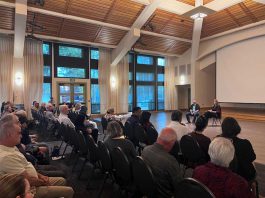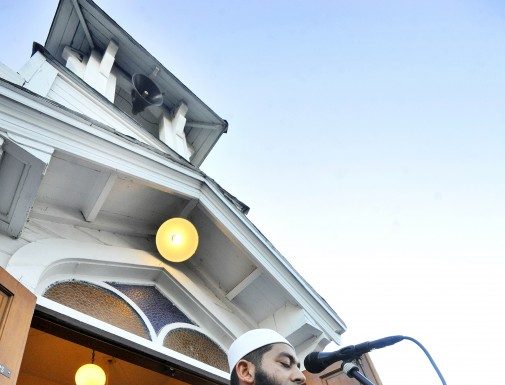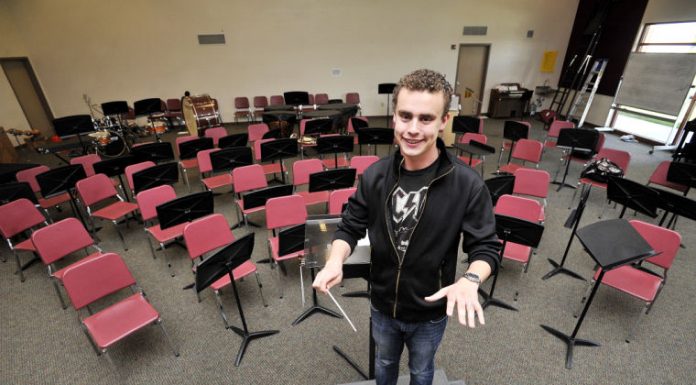Guest view: History supports city’s SE Quad plan
I grew up on a prune ranch on Fisher Avenue bought in the 1930s by my immigrant grandparents, Gataeno and Anna Forestieri. My first job was picking 10 boxes of prunes to buy a lunch box when starting kindergarten. The year was 1960.My brother Steve and I worked summers, weekends and part-time jobs. My parents were adamant that farming was not a feasible career for us. Steve and I found other careers—an engineer and court reporter, respectively.Morgan Hill is a town rich in history, and my father helped build that image and was appointed to the Federal Prune Administrative Committee by Secretary of Agriculture Bob Bergland in 1980.You must understand the past to see the future. The freeway placement, which my father Duke Forestieri fought, cut off our land to the west. Dad took on other people's orchards to make ends meet for our family. He also pursued the idea of moving to Yuba County where prune farming was beginning. My father's love of Morgan Hill instead kept him here. He continued to sharecrop but as Yuba County's production increased, it drove the price of prunes down everywhere—including in Morgan Hill.The cost of farming escalated in the Valley, as more and more restrictions were enacted, utility costs increased, and labor for harvesting became harder to find even though my dad paid top dollar and provided free housing for the seasonal workers. My dad's health began to spiral downward in his mid-70s. He gave up sharecropping and farmed only his land and the next door neighbor's..The pioneer farmers did not have stock options or golden handshakes; they had their families and their land. Dad joined others in working with the city in the 90s and early 2000s to carve out a plan for the pioneer farmers and include the needs of a growing Morgan Hill. Before he died in 2011, this plan was taking shape and he told me, “It lets people enjoy using our land, not just looking at it as they drive by, but to walk on it, play on it".This final plan has been worked on for over 15 years. It provides an area where kids who cannot afford traveling teams can improve their skills in many sports and have a better chance at the coveted spots on the high school teams.It will provide a place for community sponsored events, where families can afford the tickets for the whole family. If this cohesive plan is not put into place, landowners will go their own way, creating a haphazard tapestry for financial survival, which will not enrich our children's lives or improve the landscape.I firmly support this plan for the SEQ.Editor’s note: The Southeast Quadrant/Sports-Recreation-Leisure Urban Service Area expansion plan will be considered for approval at the March 11 meeting of the Local Agency Formation Commission. For more information, visit morganhilltimes.com or santaclaralafco.org.
Guest view: Referendum cost is ‘too much’
On Feb. 17, the Morgan Hill City Council once again displayed a lack of foresight and financial wisdom in handling Ordinance 2131. You might recall that last spring, voters signed a petition to suspend the ordinance that would change the zoning for a three-acre parcel of land on Lightpost Way and Madrone Parkway from “light industrial” to “general commercial.” The petition required the zoning change to be approved by the voters before it could be enacted. Instead of following the California Constitution, the city terminated the petition in an attempt to aid an out-of-town developer who bought the land cheaply. That developer will now make a windfall with the city council rezoning the land to commercial, which is worth more. Now the city is being sued by the Hotel Coalition for failing to abide by the requirements of the Constitution. Who will pay the bill to defend the city? You, the taxpayer.
Guest view: Government not the solution to homelessness
I am responding to your guest view by Sen. Bill Monning, Jan. 22. The discussion of homelessness and mental illness has been a perennial discussion. There have been calls for affordable housing, an end to homelessness, and support for mental illness for as long as I can remember. Monning’s guest view is no different.Today we put way too much credit in the opinions, suggestions and programs pushed by politicians. Based on the continuing nature of the problem, the suggestions and work of the politicians and the government has been ineffective. I recall an essay by Bertrand Russell, “An Outline of Intellectual Rubbish.”It is an essay that should be mandatory reading by anyone that is concerned with the operation of government.“As soon as we abandon our reason, and are content to rely on authority, there is no good end to our troubles. Whose authority?” Russell writes.He was referring to people’s practice of relying on scripture. I choose to believe that he would also consider the reliance on the words of a politician, as if they were scripture, as almost the same thing. Mr. Monning is pushing the same old, but repackaged, ideas as solving a problem that has yet to be solved. His conclusions are optimistic at best and unfounded at their worst. They are based on anecdotal evidence and wishful thinking. He ignores criticisms of his ideas. There is not unanimity in the arena of affordable housing, homelessness or mental illness that promotes a one-size-fits-all solution.One-size-fits-all solutions come part and parcel with politicians like Mr. Monning. It gives them access to lots of money handed out by the federal government. It also allows them to pretend that they lead solutions, which supports their reelection.“Politics is largely governed by sententious platitudes which are devoid of truth.” Those words by Russell still ring true today:“The power of governments over men’s beliefs has been very great ever since the rise of large states….But the power of governments over belief in the present day is vastly greater than at any earlier time. A belief, however untrue, is important when it dominates the action of masses of men.”Russell was referring to war, but it could easily reference any effort by government and politicians to influence belief. He laments:“No one can deny, in the face of evidence, that it is easy, given military power to produce a population of fanatical lunatics. It would be equally easy to produce a population of sane and reasonable people, but many governments do not wish to do so, since such people would fail to admire the politicians who are at the head of these governments.“I am persuaded that there is absolutely no limit to the absurdities that can, by government action, come to be generally believed. Give me an adequate army, with power to provide it with more pay and better food than falls to the lot of the average man, and I will undertake within 30 years to make the majority of the population believe that two and two are three, that water freezes when it gets hot and boils when it gets cold, or any other nonsense that might seem to serve the interest of the state.”It should be understood that the essay was written six decades ago. He continues with some additional important observations that you can read for yourself.It is worthy to think of ways to help the homeless and the mentally ill. I choose to reject the ideas that come from politicians or government. Clearly these solutions have proved ineffectual by the persistence of most of the problems. Claims of success are either wishful thinking or out and out lies.The involvement of government has been counter-productive. Government programs do not solve problems because problems are generally complex and defy central planning. Flexible and innovative approaches tried by a host of problem solvers will always outperform top-down government and political solutions.So by all means address the plight of mentally ill and homeless. Just don’t count on government or politicians to do it. So maybe government and politicians should step back and not lead. Rather they should listen to quiet voices that speak and advocate for real solutions.Mike Brusa is a retired Morgan Hill resident and an avid reader of history, politics and economics.
Guest view: Social media can promote, preserve community
It’s no surprise that our lives have become more hectic and fragmented each day.As part of our daily existence, we look to snippets of information in our community circles. Whether by news reports, friends, family or the increasing dependence on social media to stay connected, small bites of information we receive are the key to staying informed.Some time ago, I started working on specific Facebook Groups and other digital communities to help keep busy folks informed. These concerned the areas that mattered most to others and myself—one of which was our community here in Morgan Hill. As the founder of the Morgan Hill Community Group Page (MHCG) on Facebook, there was growing need for our residents to have a centralized place to receive rapid information in our community from fellow residents. “By the residents, for the residents” is our credo, without City or government influence. Beyond other current happenings and discussions, topics like growth, crime and where can I find specific goods, services and more, has now become valuable to the group.Over the past year, the Morgan Hill Community Group page on Facebook has experienced growth. The once silent voice of residents is now rising up to engage many topics they previously didn’t have time or a venue for. This new-age way of communicating through social media is something I have advocated for many years. It provides each of us a simplified, fast and low-impact way to share our input in a massive venue.Another interesting aspect of the MHCG page is that more residents are engaging with each other to form smaller sub-social groups that use the page as a conduit for social good. More than once MHCG has joined residents together to save lost pets, help homeless in need and build community around our concerns of city growth. Even Bay Area news channels have fed off the good coming from the Morgan Hill community and MHCG page.While it’s not perfect, it’s shaping to become a catalyst that will change our view on Morgan Hill’s direction and commitment to a better community. In polls placed on the MHCG page, majorities are extremely biased on core areas of growth, city expenditures and lack of resident involvement in large decisions. This socialized communication is the shape of the future, and how the silent majority finds a voice again to reflect what “community” means to them.It’s also easy to envision how this model could allow our City Hall leaders a certified resident “e-vote” system to shape the residents’ desires for our future. This is another important topic I greatly advocate we consider.Being a native of Santa Clara County, I’m proud that our residents have stepped up to the plate recently through the MHCG page on Facebook and made Morgan Hill a community others wish to model. That spirit resides solely in each of those engaged positively in the group and helps make in a small way our Morgan Hill community a wonderful place to live.Steve “Papi” Chappell is a Morgan Hill resident and business owner. He is also a record holding champion in Land Speed Racing and the founder of the Morgan Hill Community Group Page on Facebook, which can be found at facebook.com/groups/MorganHillCommunityGroupPage/.
Guest view: Proposed water rates unfair, divisive
In late November 2015, a plan of sorts was proposed by the city of Morgan Hill where water rates for hillside communities would be raised considerably. Depending on where you lived, starting in 2016 some residents would pay up to 300 percent more than the previous year. It was argued that it was only fair since extra costs were incurred to serve the hillside residents. In early December and after much discussion coupled with a petition submitted to the city council, the planned increase was modified and the city proposed that hillside residents pay a surcharge to cover the electrical cost for pumping water up to hillside properties. This will become a “done deal” later this month when addressed by the city council.I’m in my fortieth year of living in Jackson Oaks, and I believe it is ill advised to create classes of ratepayers when paying for city services. I’m against this approach as I believe it is divisive to the city at large.In my neighborhood, there are no curbs or sidewalks and the streets are so narrow that only the brave try parking a car on the street. The amount of street lighting in the hillside is scant versus many areas in the flat land. I can recall seeing a street cleaner once in my 40 years of hillside living. There are no city parks in or close to my neighborhood. All of these have costs tied to them and it’s fair to ask, why are residents asked to pay for unequal amounts of city services? Remember when the city committed about $5 million (in conjunction with the Santa Clara Valley Water District) to renew the out-of-date environmental study for the city flood control project? Although this was Redevelopment Agency money, hillside residents are probably not going to be underwater. Do we not all remember when perchlorate threatened some of the city water supply from the Olin Corporation Tennant Avenue facility? Even though not all parts of the city were affected, a citywide surcharge was imposed to pay for equipment to filter out the perchlorate at contaminated wells.The police know the areas in the city where their resource is spent, just as they know where there is less (or little) crime or public safety issues. Why not create classes of ratepayers in the city to make it fair? Use more, pay more.What does this have to do with paying for the electrical power to pump water to hillside residents? Let’s be clear: Morgan Hill is a city, and city services should come with a flat rate structure for all services, including water. I don’t support classes of users allocated on costs. The perchlorate citywide surcharge was just. The notion that police costs should be set up by zone is nuts. I defend the city’s flood control expenditures. As for Jackson Oaks’ narrow streets, absence of parks or minimal street lighting, I knew this when I moved here.Also when I moved here, and for 40 years after, all city residents paid the same rate for water. It was sound policy then and that wisdom should prevail today.The Morgan Hill City Council will hold a public hearing on the proposed water and wastewater rate increases 7 p.m. Jan. 20, at council meeting chambers, 17555 Peak Ave.
Guest view: Bigotry shames the community
Times of crisis, distress and violence too often expose our deeply held fears. People of faith share much in common: a desire for a peaceful world, respect for one another and a commitment to strive collaboratively to advance social justice and the common good. Current attempts to isolate and demonize our Muslim sisters and brothers violate the foundation of our shared beliefs.
Mayor Steve Tate: SE Quad plan preserves ag
Like all of Santa Clara County, Morgan Hill has a rich agricultural history. Most of today's remaining actively grown agriculture (ag) is in South County. To preserve our region's proud history, residents throughout the county want to see active ag preserved to the maximum extent possible. Our community has invested significant time and resources in evaluating alternatives to preserve viable ag. Morgan Hill's forward thinking, citywide Agricultural Preservation Program was developed with guidance from respected ag preservation and economic consultants. It includes a "stay ahead" provision requiring preservation to occur before development.Morgan Hill has pledged to invest millions of dollars in ag preservation from a fund that continues to grow as the city develops. We have a plan that effectively saves the most ag while providing other benefits to our community and region.It is unrealistic to think that if we don't change anything, South County ag land will remain ag. We have ample evidence to the contrary. Every parcel in unincorporated South County has development rights, including active ag parcels.San Martin is a visual example of ag land turned into housing on large acreage parcels. If you go to the south end of Trail Drive, you'll see five homes under construction. It is literally happening now! House by house, our ag lands will disappear unless we do something different.Morgan Hill is doing something different and innovative. One way to guarantee that these lands remain ag is to remove their development rights by recording a permanent ag easement on the deeds. Land owners will do this—for a price.The city will assure that any ag land developed in or around Morgan Hill preserves an equal amount of designated ag land in the area southeast of the city. It can do this by supplementing payments from an open space account funded by developers who compete for housing allocations in the city. Housing development in the city assists in preserving ag lands in the surrounding county.We are also working with landowners on other innovative approaches to compensating them for ag easements.Morgan Hill has a great reputation for providing high quality recreation facilities. Another creative way to fund ag preservation is to annex a small portion of the area (less than 180 acres) near the Tenant-101 interchange to enhance its family and youth-oriented recreation, sports and leisure offerings. Morgan Hill can leverage its reputation by expanding its active recreation facilities.This envisioned development will pay ag preservation fees, so it will assist in preserving ag in the surrounding county.Another planned use for the southeast area is a new Catholic high school on land owned by the church near the Tenant-101 interchange. It will be a tremendous South County asset, and its development will also help fund ag preservation.Morgan Hill's plans do not add any housing to these areas. None.Consistent with the widely accepted Santa Clara Food and Farmlands Resolution, Morgan Hill is working diligently to insure that small-scale ag remains viable in our sphere of influence. We are seeking the services of a third-party administrator to oversee easements and explore creative ways to provide ag infrastructure to small-scale farmers.To make ag preservation a reality, Morgan Hill is working closely with our Local Agency Formation Commission (LAFCO) to gain approval to annex the land for recreation and the Catholic high school. A hearing is scheduled Feb. 3. It is imperative for LAFCo to approve our application, as it proactively and responsibly preserves viable ag while also providing quality community-serving facilities.Steve Tate is the mayor of Morgan Hill. The Feb. 3 LAFCO meeting will take place at the county’s board meeting chambers, 70 West Hedding Street, San Jose.
Guest view: Donate to help our furry and fine-feathered friends
To get a warm and fuzzy feeling this holiday season, consider donating to a local animal care organization such as wildlife rehabilitation, pet shelter, and animal rescue group, who are always in need of that extra helping of generosity.Giving to a local organization enhances your community and produces immediate and visible results. Many of these organizations, including the Wildlife Education and Rehabilitation Center, are supported solely by donations from individuals and companies. A donation to your favorite animal charity can make a heart warming, deeply appreciated gift and gives the giver a feeling of goodwill (and a tax deduction, too).A word of warning: Beware of fly-by-night “charities.” Check out an organization before sending off a check. If you’re not familiar with the organization, ask for the phone number and address. Call to see if they’re reputable or have them send you more information. The organization should have a 501(c)(3) tax exemption number. It’s your hard earned money—don’t hesitate to ask questions regarding where that money goes.W.E.R.C. wishes to thank all in our community who have generously donated throughout the year to help us help the helpless, injured and orphaned native wildlife that would not have survived on their own.Sue Howell is the Executive Director of the Wildlife Education and Rehabilitation Center in Morgan Hill.
Guest view: A holiday wish from your state senator
During the holiday season it is easy to become overwhelmed with errands and tasks that are inherently linked to this time of year, such as shopping for gifts, baking and visiting family and friends.
Guest view: Sobrato alum featured at South Valley Symphony holiday concert
Music brings people together. With the holidays now in high gear, the South Valley Symphony welcomes everyone in Hollister, Gilroy, San Martin and Morgan Hill communities to celebrate the joy and cheer of the season with festive symphonic music at the “Holiday Panorama” concert at the Gavilan Community College Theater 4 p.m. Dec. 13.At this concert, we will honor the victims of the terrorist attacks in Paris with a special piece composed by Sobrato High School graduate Christopher Niemann. The young man's piece is very poignant and personal, and I feel amazed that something of this quality was composed in a few days. Niemann told me he needed to write something to use music as healing for what happened in Paris. In a matter of days he completed a full-orchestral piece as a remembrance of those who died in Paris.The symphony made the decision to have the orchestra perform the new piece at the winter concert because the holiday season is a “season of giving” and the music can help people heal after a tragedy.A 2013 graduate of Sobrato where he first developed his talent in music composition, Niemann, 20, said he hopes the audience will feel motivated to move on from this tragedy after hearing the composition.“Being barely old enough to remember the 9/11 attacks and living through the aftermath, I remember the sensation of being extremely helpless,” he said. “Everyone from around the world watching such terrible events happen through the news and wanting to help when all you could do was watch. I never thought that I would have to experience that feeling of helplessness again. The idea to create a piece in honor of the victims came through the feeling of helplessness; because it’s very hard to just sit and do nothing when people around you are suffering.”Niemann has composed and conducted several pieces performed by the South Valley Symphony, including at the Oct. 10 concert a special composition called “In the Halls of the Overlook” based on the Stephen King novel “The Shining.”The selection of other pieces at the concert will give the audience a festive feeling for the holidays. Top billing at the concert will go to two guest artists—soprano Milena Georgieva who will sing Mozart’s “Exsultate Jubilate” and soloist Greg Chambers performing John Williams’ “Escapades for Saxophone & Orchestra.” The orchestra will also perform selections from Tchaikovsky’s ballet “Sleeping Beauty.” Leroy Anderson’s “Christmas Festival” will complete the concert with a medley of songs taking the audience into the festive spirit of the season.Greg Chambers is a music teacher at Sobrato High School and a master of the saxophone. The solo “Escapades” that he will perform is based on Williams’ film score for the 2002 Steven Spielberg movie “Catch Me If You Can.”Along with the Mother’s Day concert at the San Juan Bautista Mission, the symphony’s holiday concert is so popular that it usually sells out, so buy your tickets early online on the symphony’s website atsouthvalleysymphony.org or at Morgan Hill’s BookSmart store, Gilroy’s Porcellas Music and First Street Cafe, Hollister’s PostalGraphics or San Juan Bautista’s The Mission Gallery.We encourage families to share the festive fun of the holidays by attending the upcoming concert. Children can attend for free with accompanying paying adult (but the child must get a ticket to be admitted). Students with identification can also attend the concerts for free. During the intermission, I invite children on the stage to learn about the various instruments.The South Valley Symphony is a family, and we welcome everyone to celebrate the season at our Holiday Panorama concert this Sunday.Anthony Quartuccio is the Music Director and Conductor of the South Valley Symphony.

















